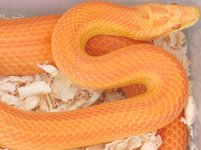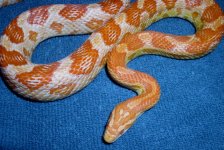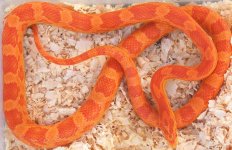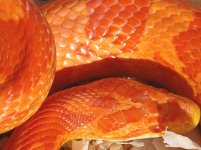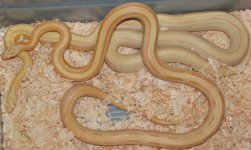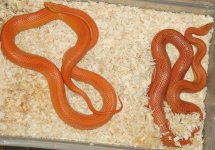Charlie said:
After finding out whether or not she is indeed homo hypo...would you breed her back to the butter stripe male to see if you get hypo butter stripes from the pair? Would you be able to pick out the difference in the clutch between homo hypo and regular butter stripes?
I am not sure who I would breed her to if she does prove to be homo for Hypo. It seems likely that we could pick out the homo Hypo Striped Butters if her drastic difference in appearance is cause by the addition of the Hypo gene. It seems likely, due to the difference in Ambers and Caramels. Add the Amel gene to them, and we would expect something like what I am seeing. Also, we have seen a different phenotype in Hypo Sunkisseds, and I believe Hypo Amels as well. I can pick out Lavamels with 100% accuracy from their Amel Okeetee clutch mates, but what if they came from a Sunglow line? It might not be so easy then.
I only have the one pair of Striped Butters, so my first thought was I would like to produce more, but the male will be bred to Amel Stripes so I will have some nice Amel Stripes het Caramel to hold back. Out crosses are always nice to hold back for several reasons. Also, in time, The Hypo Striped het Lavender Caramels will produce some Striped Butters poss hets which will be the ultimate out crosses to hold back if you ask me.
Sometimes too much of a good thing is not as good as some of its parts. I prefer the male Striped Butters appearance over the females. Striped Ambers look pretty awesome, so the benefit to having a Corn with too many genes is the variety of offspring that you can produce in one clutch.
Check out the predicted results from the test breeding above if she proved to be homo for Hypo. The same results will be possible even if she is not, but the percentages will be much higher for most morphs. I wasn’t even thinking about the Amel gene being in the mix too. I would love to see this clutch hatch!
Male = Hypomelanistic, Stripe het. Butter, het. Amel, het. Caramel, het. Lavender
Female = Hypomelanistic, Stripe het. Butter, het. Amel, het. Caramel, het. Lavender
Offspring predicted as:
---This is a PHENOTYPE only report-----------------
27/64 Hypomelanistic, Stripe
9/64 Amelanistic, Hypomelanistic, Stripe
9/64 Amber, Stripe
3/64 Butter, Hypomelanistic, Stripe
9/64 Hypomelanistic, Lavender, Stripe
3/64 Amelanistic, Hypomelanistic, Lavender, Stripe
3/64 Amber, Lavender, Stripe
1/64 Butter, Hypomelanistic, Lavender, Stripe
What will an Striped Opal Caramel or Striped Butter Lavender look like anyway? Somewhere between an Opal Striped and Butter Striped or something else.

